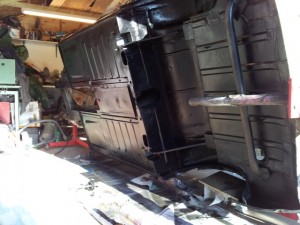The cold weather put a stop to finishing the spraying so early December I had to find something else to work on. The back axle & spring assembly had been stored under cover beside the shed so this was moved into the dry for some attention.
I will be so glad when all the cleaning of greasy and rusty parts is over and the axle was a mess. Here’s the axle before I started.

The spring mounting pads were seized.

The axle was completely stripped down. The front metalastic bushes were drilled out and everything was cleaned with a wire wheel and rust treated then coated with some chassis black.
The diff was rough to turn so was stripped and needed a new pinion oil seal and the pinion front bearing was worn. At this point the list of parts required was growing.
Attention turned to the front suspension and more stripping, removing of grease and rust was undertaken. The kingpins were removed and it then became apparent that the lower bearing surface was corroded and the kingpins were a loose fit into the stub axle.

Attempting to remove the kingpins from the wishbones revealed the next issue. The fulcrum pins were seized to the kingpins and the trunion had a lot of play in the threads. Cue more expense, this time for a set of wishbones. However rather than pay £60 each for standard pattern parts I took what I hope is the better route and purchased a pair of Barry KIng premium wishbones – see http://www.spridgetwishbone.co.uk for more details.

Among the pile of spares I’d been acquiring was a pair of new king pins and fitting. The new king pins were tried in the uprights had the lower bushes were shot. The old ones were drifted out and new ones drifted in and then reamed using a reamer I’d purchased over a year ago. It would have been as cheap to buy refurbished ones but I wanted the challenge and I’m rather enjoying all this.
As you work though these tasks you find that more parts are worn or broken so more parts have been ordered. Even things like 3/8″ UNF bolts had to be ordered because I didn’t realise I’d need so many. I was thinking of replacing UNF bolts with metric ones but the number of captive nuts and studs would have cause confusion so I’m sticking with the UNF bolts where originally fitted and will use the metric ones on the engine.
As of January 24th the axle, diff and spring assembly has been bolted to the chassis. The handbrake linkages were worn so the holes were welded up and then re-drilled and all painted etc to look good.

With the axle fitted attention was turned back to the front and it was assembled and included poly bushes as well. The original dampers have been retained for now but will probably be modified once the car is on the road. I want to experience the improvements with each change rather than just throw them all on now plus if I did that I’d never finish it.

This is the nearside fitted and just the offside to go. I’ve also been working on the pedal box and made up some 1/4″ spacers to space the clutch and brake cylinders away from the housing. The effect of this is to move the pedals just over an inch towards the bulkhead. Apparently there is still enough pedal travel if you do this…..time will tell if this is the case but being close on 6’2″ I need as much space as possible.
Edit: April 2013. Spacing the master cylinders to move the pedals resulted in insufficient pedal travel so the spacers were removed.

Here’s the suspension bolted in and the pedal box was about to be assembled and fitted.
Next step will be to plumb in the brake lines then drop in the engine.



















